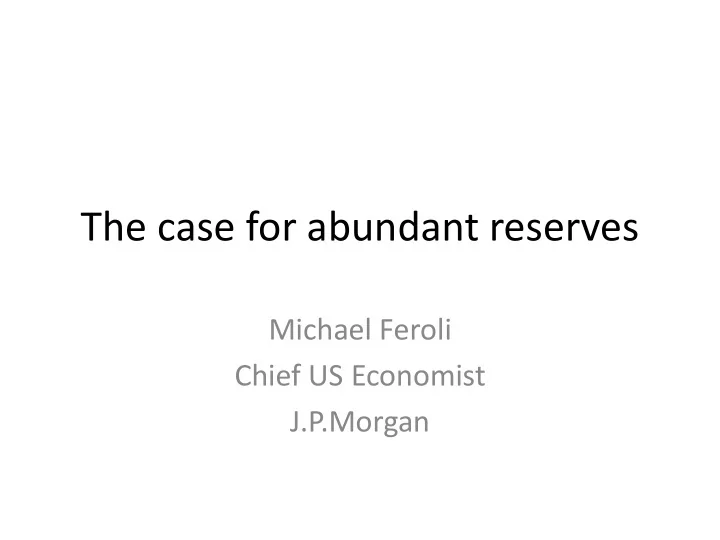

The case for abundant reserves Michael Feroli Chief US Economist J.P.Morgan
Excess reserves: scarcity vs. abundance • Debate is sometimes framed as a corridor vs. a floor • In my experience this terminology has confused general listeners – Old system wasn’t a corridor, nor is the new system a floor
Going from abundance to scarcity • Is it feasible? That is, would it work as smoothly as it did prior to 2007? • Is it optimal? If we can get scarcity to work smoothly, would that be the best system?
Preview of conclusions • Returning to scarcity would be feasible, but would require coordination with other official bodies • Harder to argue scarcity is optimal – Historical precedent seems less compelling, as historically the Fed didn’t have an IOR facility – Abundance protects the Fed balance sheet, improves payment system functioning, and may have other benefits as well
Feasibility: what is different from 2006? Factors Absorbing Reserve funds: • Payment volumes Treasury deposits with F.R. Banks haven’t increased much weekly change, million USD (eop) 150000 • Autonomous factor 100000 volatility has increased, particularly Treasury’s 50000 general account 0 -50000 -100000 -150000 90 95 00 05 10 15 Source: Federal Reserve Board, J.P. Morgan
Feasibility: what is different from 2006? • Regulatory regime shift – LCR: replacing reserves with other (mostly) HQLA – CLAR: Comprehensive Liquidity Assessment and Review • Public documents indicate tests of liquidity stress scenarios • Not all HQLA created equally. Reserves have settlement immediacy that even Treasuries lack – Banks internal liquidity standards may have changed, particularly with respect to intraday liquidity
Optimality: if we can go back, should we? • Arguments for abundant reserves: – Operational simplicity – Reduced credit risk to the Fed – Reduced settlement risk in the banking system – Less inter-day interest rate volatility – Public provision of safe, short-term assets
Reducing Fed credit risk: with abundancy, reserves are bought, not borrowed
Improved payments liquidity (borrowing from Bech, Martin, and McAndrews)
Lower inter-day interest rate volatility Federal funds rate daily change, % per annum 8 6 4 2 0 -2 -4 -6 -8 79 84 89 94 99 04 09 14 Source: Federal Reserve Board, J.P. Morgan
Conclusions • Staying with the current system would be operationally simpler, particularly in the transition period • Abundant reserve balances minimize the Fed’s credit risk • They would also support better functioning of the payments system, with associated benefits • Interest rate volatility can be expected to be lower with abundant reserves • Public provision of safe, short-term assets: this may get too close to mission creep
Recommend
More recommend